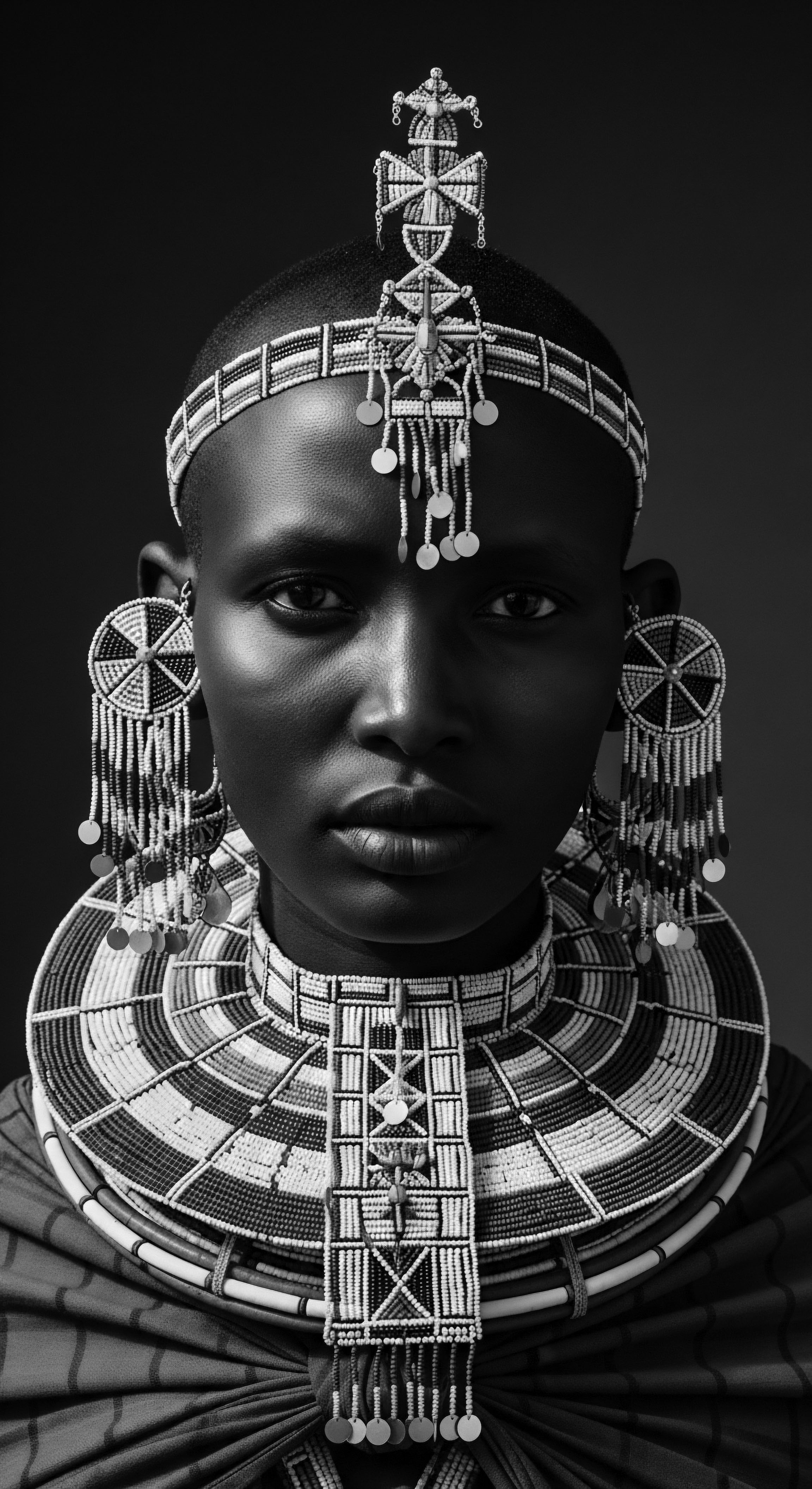
Roots
Our strands, each coiled and wondrous, carry whispers of deep time. They are not merely protein filaments; they are living archives, etched with the story of our lineage. To truly understand the resilience of textured hair, we must journey back, to a time when human bodies moved in rhythm with the land, and sustenance was intimately tied to survival.
The profound question of how diet and textured hair’s strength connect finds its earliest answers in the very cradle of humanity, in the ancient foodways that nourished our ancestors, shaping their physiology, and yes, even the very structure of their crowns. Our heritage, a vibrant thread woven through millennia, speaks through every curl and coil, reminding us that the vigor of our hair is a testament to the bounty that sustained generations.
The historical vigor of textured hair finds its earliest echo in the nutritional landscape of ancient ancestral diets.

Hair’s Deep Lineage
The origins of textured hair, those magnificent spirals and zig-zags that defy easy categorization, are inextricably linked to the evolutionary journey of humanity in diverse environments, particularly across the African continent. This hair type, with its inherent strength and unique architecture, evolved over vast stretches of time, offering protection from harsh solar radiation and aiding thermoregulation. The very building blocks of this protective crown – the proteins, the lipids, the intricate disulfide bonds – were synthesized from the raw materials available in ancestral diets. Early human diets were, by necessity, incredibly varied and nutrient-dense, a symphony of wild game, fish, tubers, fruits, and indigenous greens.
This rich nutritional intake laid the biochemical foundation for the robust keratin structures that define textured hair, providing the necessary amino acids, vitamins, and minerals required for optimal growth and durability. The ancestral human body, a marvel of adaptation, processed these diverse foods, channeling their potent energies into every aspect of physiological wellbeing, including the resilience and vitality expressed through hair.

Echoes from the Source
Consider the ancient foodways, a testament to ingenious methods of harvesting and preparing nature’s offerings. Our forebears were master foragers and hunters, deeply attuned to the rhythms of their environment. Their sustenance was not processed or refined; it was whole, alive with enzymes, vitamins, and minerals.
- Wild Game and Fish A primary source of complete proteins, essential for keratin synthesis, and healthy fats, which contributed to scalp health and hair luster.
- Root Vegetables and Tubers Provided complex carbohydrates for sustained energy, along with an array of vitamins and dietary fiber.
- Leafy Greens and Wild Fruits Abundant in vitamins A, C, and E, powerful antioxidants that shielded hair follicles from environmental stress, alongside vital minerals like iron and calcium.
These dietary patterns, characterized by an absence of refined sugars, excessive saturated fats, and processed ingredients, fostered an internal environment conducive to robust health. Such a diet inherently supported cellular integrity, efficient nutrient delivery to the hair follicles, and systemic wellness that manifested outwardly as strong, vibrant hair. The deep dark hues of many traditional foods, indicators of rich antioxidant profiles, speak to their potency. The very act of consuming these ancestral foods was a ritual of connection to the earth and to the body’s intrinsic need for pure sustenance, a legacy that continues to resonate.

Mineral Richness and Ancient Hair
The connection between the earth’s mineral wealth and the fortitude of ancestral hair is profound. Iron, a mineral often deficient in modern diets, was historically abundant in the meat and certain leafy greens consumed by our ancestors. Iron is indispensable for oxygen transport to the hair follicles, a process critical for healthy growth and preventing breakage.
Zinc, another vital mineral, found in wild game and legumes, played a role in protein synthesis and cell division, directly influencing the hair shaft’s strength and repair mechanisms. Similarly, the diverse array of plant-based foods ensured a steady supply of biotin and other B vitamins, co-factors in metabolic pathways essential for keratin production.
This synergy between mineral-rich diets and hair resilience was not merely incidental; it was foundational. The very strength of hair was, in a very real sense, a reflection of the land’s generosity and the ancestral ability to draw sustenance from it. The robust, often dense texture of ancestral hair, known for its ability to withstand environmental stressors, was a biological testament to this dietary completeness. These were not just physical attributes; they were visual markers of a healthy, well-nourished lineage.

The Soil, the Sustenance, the Strand
The relationship between the fertility of the soil and the vitality of human hair might seem distant, yet it holds a deep historical truth. Where the soil was rich and diversified, supporting a wide array of plant and animal life, the human populations drawing from it would have access to a more complete nutritional spectrum. This ecological interplay meant that the health of the land directly translated into the health of its people, and by extension, the strength of their hair.
Periods of drought, famine, or forced displacement would have disrupted this delicate balance, leading to nutritional deficiencies that would visibly impact hair quality, causing thinning, brittleness, or changes in texture. This interconnectedness is a powerful reminder that our bodies, and our hair, are deeply rooted in the wider ecosystem of our heritage.
| Dietary Element Wild Game and Fish |
| Key Nutrients Provided Complete Proteins, Omega-3s, Iron, Zinc |
| Impact on Hair Resilience Essential for keratin building blocks, scalp health, and oxygen delivery to follicles. |
| Dietary Element Tubers and Root Vegetables |
| Key Nutrients Provided Complex Carbohydrates, B Vitamins, Magnesium |
| Impact on Hair Resilience Sustained energy for hair growth, supports metabolic processes crucial for cell division. |
| Dietary Element Leafy Greens and Wild Fruits |
| Key Nutrients Provided Vitamins A, C, E, Antioxidants, Iron, Folate |
| Impact on Hair Resilience Protects follicles from damage, aids collagen synthesis, supports blood circulation to the scalp. |
| Dietary Element These foundational foods provided the necessary raw materials for developing and maintaining the innate strength of textured hair across generations. |

Ritual
From the elemental sustenance of the land, our exploration moves to the intentionality of living traditions, to the ‘ritual’ of daily existence where food became more than mere fuel. It became an act of cultural continuity, a practice imbued with purpose and ancestral wisdom. For communities with textured hair, particularly those across the African diaspora, the preparation and consumption of food were deeply intertwined with holistic wellbeing, creating a symbiotic relationship between internal nourishment and external radiance. The resilience of textured hair, in this context, was not solely a biological outcome; it was a testament to the enduring power of foodways passed down through generations, each meal a quiet prayer for strength and vitality, for every individual strand.
Ancestral culinary traditions, rich in nutrient-dense foods, acted as silent rituals contributing to the sustained strength and vibrant expression of textured hair across generations.

Living Traditions of Nourishment
Across diverse African and diasporic communities, food was, and remains, a sacred component of existence. Meals were communal, stories were shared, and ancestral knowledge of edible plants and healing preparations was meticulously transmitted from elder to youth. This cultural reverence for food meant that dietary practices were often rooted in principles that inherently supported health. The preference for whole, unprocessed foods, grown locally and harvested with care, was not just a matter of availability; it was a deeply ingrained wisdom.
These traditions often emphasized a balance of nutrients, incorporating a wide array of plant-based proteins from legumes, healthy fats from nuts and seeds, and a spectrum of colorful fruits and vegetables. This mindful approach to sustenance contributed directly to the structural integrity and vitality of hair. The hair, as a visible manifestation of inner health, reflected the richness of these dietary traditions.

Culinary Heritage and Hair Vibrancy
The cuisines of the African continent and its diaspora are a vibrant mosaic, each dish a story. Consider the prevalence of hearty stews, often containing leafy greens like collards, callaloo, or moringa – veritable powerhouses of vitamins and minerals. These greens, simmered slowly with smoked meats or fish, created nutrient-rich meals that were not only delicious but deeply nourishing.
Legumes like black-eyed peas, lentils, and beans, staples in many traditional diets, offered plant-based protein, essential for keratin production, alongside iron and zinc. The generous use of healthy oils such as palm oil (in its unrefined form, rich in vitamin E and carotenoids) or coconut oil, used in cooking and occasionally applied externally, contributed both internal and external lipid support for the hair fiber.
Such culinary patterns instinctively provided the necessary raw materials for resilient hair. A diet abundant in these elements meant consistent access to amino acids for protein synthesis, B vitamins for energy metabolism in follicles, and antioxidants to protect hair cells from damage. The vibrant pigments in many traditional foods, like yams or plantains, hinted at their nutrient density, translating into a profound beauty that radiated from within, culminating in the sheen and elasticity of well-nourished hair.

The Wisdom of Shared Meals
Beyond the mere biochemical components, the very act of preparing and sharing meals held significant cultural weight. In many ancestral communities, collective food preparation was a cornerstone of social cohesion, a time for intergenerational learning and communal support. This collective sustenance, rich in both nutrients and social connection, fostered a holistic wellbeing that permeated every aspect of life, including physical appearance.
The stress-reducing effects of community, coupled with nutrient-dense sustenance, created an optimal internal environment where the body could dedicate resources to non-essential functions like hair growth and maintenance. The strength of the collective was mirrored in the strength of individual strands, a poignant visual link between communal health and personal resilience.

Herbal Potions and Internal Elixirs
Ancestral wisdom often blurred the lines between food, medicine, and beauty. Many plants and herbs used in traditional cooking also possessed medicinal properties, and their consumption contributed to overall health, indirectly supporting hair vitality. Think of traditional teas brewed from ginger, turmeric, or hibiscus, known for their anti-inflammatory and antioxidant properties. These internal elixirs worked synergistically with nutrient-rich foods to maintain systemic balance, a prerequisite for healthy hair.
While external oiling and herbal rinses were common, the understanding that true radiance began from within was deeply ingrained. The strength of the hair was seen as a reflection of the body’s inner balance and vitality, nurtured by both the daily meal and specific herbal preparations.

Dietary Shifts and Hair’s Adaptations
The transatlantic slave trade marked a cataclysmic rupture, not only in human lives and societies but also in established foodways. Enslaved Africans were largely deprived of their traditional, nutrient-rich diets and forced to subsist on meager rations, often consisting primarily of cornmeal, salt pork, and molasses. These diets were severely deficient in critical vitamins and minerals, leading to widespread malnutrition and deficiency diseases. One stark example is the prevalence of pellagra , a deficiency of niacin (Vitamin B3), common among enslaved populations in the American South due as documented in historical health records (Kiple & Kiple, 1987).
Pellagra manifests with dermatitis, diarrhea, and dementia, and significantly impacts hair health, leading to thinning, changes in texture, and even hair loss. This stark historical example illustrates the profound and detrimental impact of dietary disruption on the body’s ability to maintain hair resilience and overall vitality.
Despite these brutal conditions, communities demonstrated incredible resilience, adapting traditional culinary knowledge to new, limited resources. They innovated, incorporating newly available plants or cultivating small garden plots when possible, finding ways to supplement their diets and maintain fragments of their food heritage. These adaptations, though often born of necessity, speak to the enduring cultural connection to food as a source of health and identity. The hair, though challenged, became a silent witness to these struggles and adaptations, its changing condition reflecting both deprivation and the persistent human spirit.

Honoring the Harvest
The reverence for food, its cultivation, and its preparation, was a cornerstone of many ancestral societies. This reverence extended to the body itself, seen as a sacred vessel. Caring for the body, through proper nourishment, was an act of honoring life, lineage, and the earth’s generosity.
This holistic worldview, where food, health, and spirit were inextricably linked, profoundly shaped how textured hair was perceived and maintained. The robust health of hair, in this context, was not a mere cosmetic outcome; it was a visible manifestation of harmonious living, a testament to the wisdom embedded in ancestral dietary practices and the deep connection to one’s heritage.
- Millet and Sorghum Grains foundational in many African diets, providing complex carbohydrates, B vitamins, and iron, essential for sustained energy and hair cell proliferation.
- Okra A mucilaginous vegetable, rich in vitamins C and K, and dietary fiber, contributing to gut health and overall nutrient absorption, which indirectly benefits hair.
- Indigenous Leafy Greens Such as amaranth, bitter leaf, or spinach, packed with vitamins A, C, E, iron, and calcium, vital for scalp circulation and follicle nourishment.

Relay
Our understanding of textured hair’s endurance, nurtured through generations, now confronts the precise gaze of contemporary science. This intersection allows us to see how the ancestral wisdom regarding diet, once intuitive knowledge passed through song and shared meal, finds validation in the molecular explanations of today. The question of how diet influences textured hair resilience is not merely historical curiosity; it is an ongoing dialogue between deep heritage and evolving discovery, revealing how the vitality of our strands continues to be a profound reflection of systemic wellbeing, intimately connected to the nourishment we receive. The relay of knowledge, from ancient practice to modern understanding, deepens our reverence for every curl and coil.
Modern nutritional science illuminates how ancestral dietary patterns biochemically supported the inherent resilience and structural integrity of textured hair.

Scientific Lens on Ancestral Diet
The foundational principles of ancestral diets – characterized by whole foods, minimal processing, and diverse nutrient sources – align remarkably with contemporary nutritional science. What our ancestors understood through observation and tradition, we now parse through molecular biology. The robust nature of traditional diets, often plant-heavy with lean proteins and healthy fats, naturally provided an anti-inflammatory environment within the body. Chronic inflammation, a silent assailant, can wreak havoc on hair follicles, disrupting growth cycles and leading to thinning or breakage.
Ancestral diets, by their very composition, minimized systemic inflammation, thereby fostering an optimal internal landscape for vibrant hair growth and maintenance. This scientific validation of heritage practices underscores the deep wisdom embedded in our foodways.

Micro and Macro Nutrients for Resilience
Diving deeper, the specific micro and macro nutrients historically abundant in traditional diets played distinct and critical roles in sustaining textured hair’s strength.

How do Specific Nutrients Fortify Hair Resilience?
Proteins, the building blocks of keratin, were readily sourced from wild game, fish, and a variety of legumes and nuts. Without adequate protein, hair becomes brittle, prone to breakage, and growth slows dramatically. Iron, frequently discussed earlier, ensures that oxygen-rich blood reaches the hair follicles, powering their metabolic activities. Vitamin C, found in abundant tropical fruits and leafy greens, is indispensable for collagen synthesis, a structural protein that supports the dermal papilla—the vital area where hair growth begins.
Furthermore, it aids in iron absorption. Healthy fats, whether from avocados, nuts, seeds, or unrefined oils, contribute to the lipid matrix of the hair shaft and scalp, maintaining moisture, flexibility, and sheen. The absence or scarcity of these dietary components, as seen during periods of severe deprivation, directly correlates with diminished hair health and resilience, underscoring their historical significance.
Consider the impact of the enslaved person’s diet in the Americas, particularly during the early periods of forced labor. The staple diet often consisted of cornmeal and pork, providing meager caloric intake and severe nutritional deficiencies. This was a stark contrast to the diverse and nutrient-rich diets of their homelands. As Kiple and Kiple (1987) note in their extensive work on the biological history of the Caribbean slave, the widespread deficiency diseases, including pellagra (niacin deficiency) and scurvy (vitamin C deficiency), were direct consequences of this dietary deprivation.
While hair health might not have been the primary focus of historical documentation, the systemic effects of such malnutrition—weakened immune systems, skin lesions, and overall physical degradation—would have undeniably manifested as compromised hair resilience ❉ dullness, increased breakage, and slowed growth, starkly illustrating the fundamental connection between diet and hair vitality. This historical period, though painful, provides a somber testament to the critical role of comprehensive nutrition in maintaining the body’s, and thus the hair’s, inherent strength.

Inflammation and Hair Wellbeing
Modern understanding of chronic inflammation provides a powerful lens through which to appreciate ancestral dietary patterns. Many traditional diets were naturally low in inflammatory triggers such as refined sugars, highly processed foods, and unhealthy fats. Instead, they were replete with anti-inflammatory compounds found in fruits, vegetables, and certain herbs. This dietary approach created an internal environment that minimized cellular stress, thereby protecting hair follicles from damage and premature shedding.
The vibrancy and apparent strength of hair, in cultures where these diets prevailed, can be seen as a direct outcome of this systemic anti-inflammatory protection. The body, unburdened by constant inflammatory responses, could dedicate its resources to optimal growth and repair, allowing hair to truly thrive.

The Gut-Hair Axis
An increasingly important area of contemporary research is the “gut-hair axis,” highlighting the profound connection between gut health and overall hair wellness. A diverse and healthy gut microbiome is crucial for efficient nutrient absorption and the synthesis of certain vitamins. Ancestral diets, rich in fiber from diverse plant sources and often including fermented foods, naturally supported a robust gut flora. This meant optimal absorption of essential nutrients needed for hair synthesis and maintenance.
When the gut is compromised, nutrient deficiencies can arise even with seemingly adequate food intake, directly impacting hair quality. This scientific insight offers a nuanced understanding of why ancestral foodways, which inherently nurtured gut health, were so effective in promoting lustrous, resilient hair, reinforcing the timeless wisdom that internal health dictates external expression.

Future Legacies
The relay of knowledge, from ancient wisdom to contemporary science, provides a powerful framework for future hair care. It underscores that true textured hair resilience is not merely about external products, but about foundational internal nourishment. By drawing upon the principles of ancestral diets—emphasizing whole, unprocessed foods, prioritizing nutrient density, and recognizing the systemic links between diet and health—we can inform contemporary practices.
This means advocating for food sovereignty, promoting access to fresh, culturally relevant produce, and re-educating ourselves on the profound connection between our plates and our strands. The legacy of textured hair resilience is not just a historical artifact; it is a living blueprint for cultivating health and beauty today, honoring the ingenuity and endurance of our forebears through mindful dietary choices.
| Historical Dietary Practice Consumption of diverse wild plants and tubers |
| Associated Nutritional Benefit Rich in vitamins A, C, B-complex; minerals like iron, zinc. |
| Modern Scientific Link to Hair Antioxidant protection, collagen synthesis, energy metabolism for follicles. |
| Historical Dietary Practice Reliance on lean proteins from wild game and fish |
| Associated Nutritional Benefit Complete amino acid profiles, healthy fats. |
| Modern Scientific Link to Hair Structural integrity of keratin, scalp health, reduced inflammation. |
| Historical Dietary Practice Inclusion of fermented foods (e.g. traditional porridges) |
| Associated Nutritional Benefit Probiotics, improved nutrient bioavailability. |
| Modern Scientific Link to Hair Gut microbiome health, optimal absorption of hair-essential nutrients. |
| Historical Dietary Practice Limited intake of processed foods and refined sugars |
| Associated Nutritional Benefit Reduced inflammatory load. |
| Modern Scientific Link to Hair Minimized follicle damage, improved blood circulation to scalp, sustained growth cycles. |
| Historical Dietary Practice The dietary wisdom of our ancestors, refined over millennia, provides a powerful and scientifically validated foundation for understanding textured hair resilience. |

Reflection
Our exploration of diet’s timeless connection to textured hair resilience arrives at a profound realization ❉ the strength and vibrancy of our strands are not isolated phenomena. They are eloquent expressions of an unbroken lineage, a biological and cultural inheritance shaped by the very sustenance that nourished our forebears. Each curl, each coil, carries the memory of fertile lands, resourceful hands, and communal tables, a living testament to ancestral ingenuity and enduring vitality. The ‘Soul of a Strand’ whispers of this deep past, reminding us that true care extends beyond the superficial.
It beckons us to look inward, to the cellular nourishment that has always been, and remains, the bedrock of hair’s fortitude. Our textured hair, then, becomes more than an adornment; it is a profound archive, continually being written with every mindful choice, every meal that honors the wisdom passed down through time. It speaks of resilience, not merely as a biological trait, but as a cultural triumph, a legacy of enduring beauty forged through generations.

References
- Kiple, Kenneth F. and Virginia H. Kiple. 1987. The Caribbean Slave ❉ A Biological History. Cambridge University Press.
- Genovese, Eugene D. 1974. Roll, Jordan, Roll ❉ The World the Slaves Made. Pantheon Books.
- Williams-Forson, Psyche A. 2004. Food and Freedom ❉ The African American Struggle for Food Security. Routledge.
- Dunn, Richard S. 1972. Sugar and Slaves ❉ The Rise of the Planter Class in the English West Indies, 1624-1713. W. W. Norton & Company.
- Pollock, Nancy J. 1995. These Roots Remain ❉ Food Habits of the Displaced Peoples of Eastern Africa. Zed Books.
- Nestle, Marion. 2013. Food Politics ❉ How the Food Industry Influences Nutrition and Health. University of California Press.
- Eaton, S. Boyd, and Melvin Konner. 1985. “Paleolithic Nutrition ❉ A Consideration of Its Nature and Current Implications.” The New England Journal of Medicine, vol. 312, no. 5, pp. 283-289.
- Scrimshaw, Nevin S. and Vernon R. Young. 1989. Protein-Energy Malnutrition ❉ Its Epidemiology and Control. World Health Organization.
